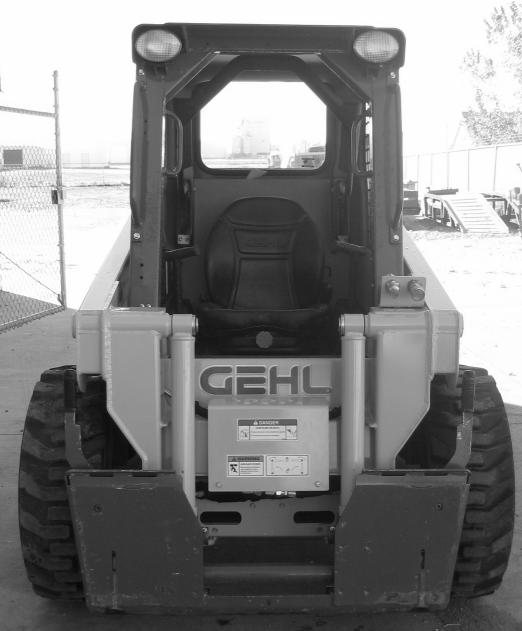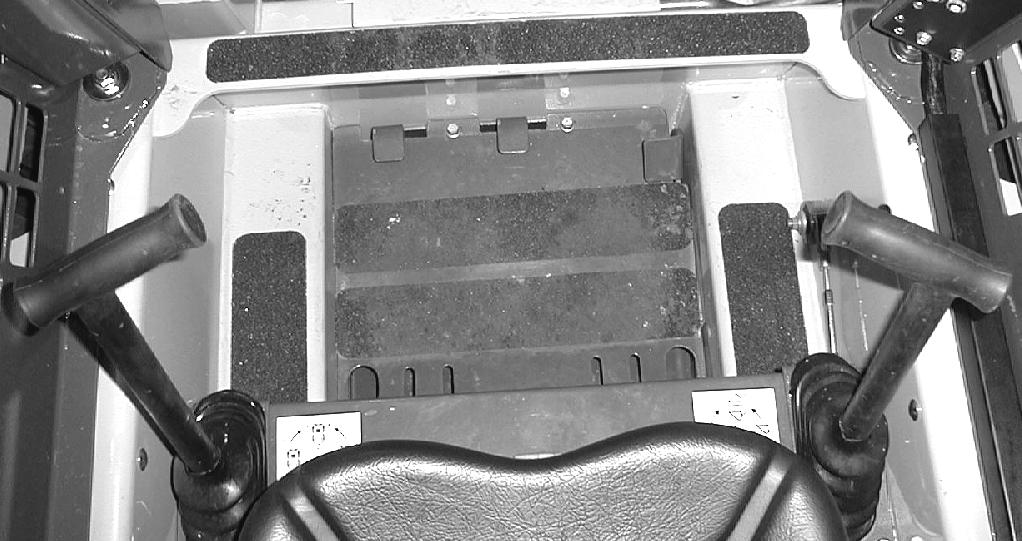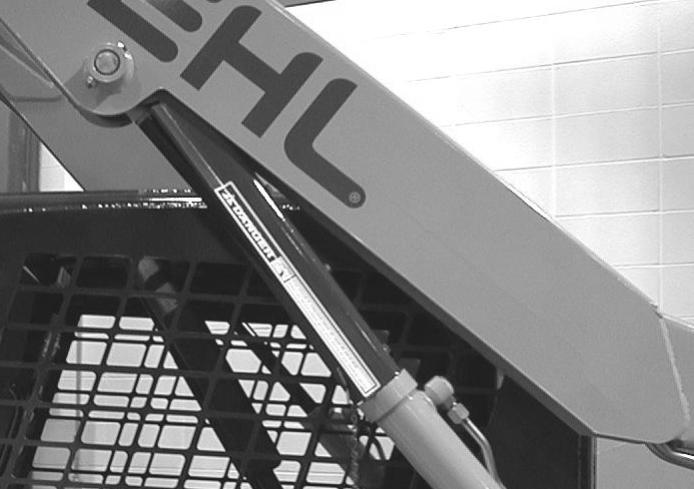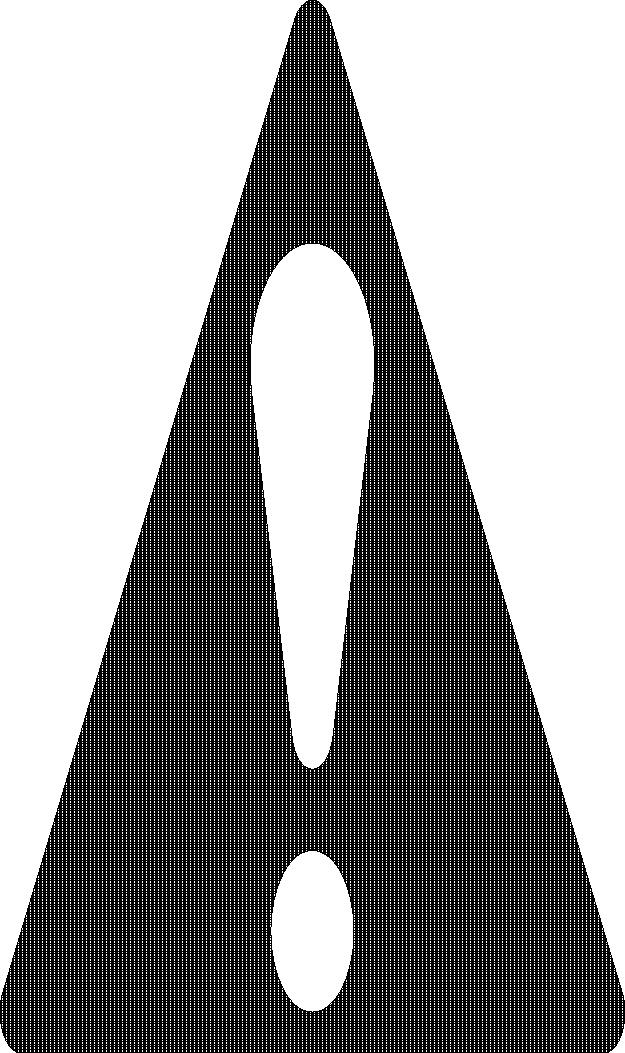
8 minute read
Changing Attachments
from Gehl SL3640E SL3840E (EU) SL4240E SL4240E (EU) Skid-Steer Loaders Operator's Manual 917334-E0819
To prevent unexpected attachment release from the attachment bracket, be sure to properly secure the latch pins by rotating the latch levers to a horizontal position.
The skid-steer loader features a All-Tach™ attaching mechanism for mounting a bucket or other attachment. Two latch levers secure the attachment.
Connecting an Attachment
1. Rotate the latch levers to a vertical position to fully retract the latch pins.
2. Start the loader engine and make sure the lift arm is lowered and in contact with the loader frame.
3. Align the loader squarely with the back of the attachment.
4. Tilt the attachment bracket forward until the top edge of the bracket is below the flange on the back side of the attachment and centered between the vertical plates.
5. Slowly drive the loader forward and, at the same time, tilt the attachment bracket back to engage the flange on the back side of the attachment.
6. Stop forward travel when the flange is engaged, but continue to tilt the attachment bracket back to lift the attachment off the ground.
7. Exercise the MANDATORY SAFETY SHUTDOWN PROCEDURE (page 6).
8. With the loader engine OFF, leave the operator’s compartment and rotate the latch levers to a horizontal position to fully engage the latch pins.
Important: To check that the attachment is properly installed, apply down pressure to the attachment prior to operating.
Connecting Auxiliary Hydraulic Couplings
Note: With the engine OFF, key in the ON position and the restraint bar down, the auxiliary hydraulic control can be moved to relieve any pressure in the hydraulic system.
The hydraulic couplers are located on the left lift arm. “A” port is pressure, “B” port is return when the auxiliary control is in the detent position.
Removing Attachments
1. Tilt the attachment bracket back until the attachment is off the ground.
2. Exercise the MANDATORY SAFETY SHUTDOWN PROCEDURE (page 6).
3. Relieve any hydraulic pressure in the auxiliary and attachment lines.
a. Turn the key switch, but do not start the engine.
b. With the restraint bar down, move the auxiliary hydraulic control back and forth. This will relieve the pressure in the hydraulic system.
4. With the engine OFF, leave the operator’s compartment, disconnect the auxiliary hydraulic hoses and rotate the latch levers completely vertical to fully retract the latch pins.
5. Start the engine and be sure that the lift arm is fully lowered and in contact with the loader frame.
6. Tilt forward and slowly back the loader until the attachment is free from the loader.
Self-Leveling (optional)
The feature is designed to keep the attachment level while the lift arm is being raised.
Using a Bucket
Always maintain a safe distance from electric power lines and avoid contact with any electrically charged conductor or gas line. Accidental contact or rupture can result in electrocution or an explosion. Contact the “Digger’s Hotline” or proper local authorities for utility line locations before starting to dig.
Driving over Rough Terrain
When traveling over rough terrain, drive slowly with the bucket lowered.
Driving on an Incline
When traveling up or down on an incline, travel with the heavy end pointing uphill. Try to avoid traveling on an incline, but always travel with the bucket as possible to maintain stability.
Loading a Bucket
Approach the pile with the lift arm fully lowered and the bucket tilted slightly forward until the edge contacts the ground. Drive forward, lifting the lift arm and tilting back the bucket to fill it. Back away from the pile.
Always carry the loaded bucket with the lift arm resting on the loader frame. For additional stability when operating on inclines, always travel with the heavier end of the loader toward the top of the incline.
Digging with a Bucket
Approach the digging site with the lift arm slightly raised and the bucket tilted forward until the edge contacts the ground. Break the ground by driving forward and gradually lowering the lift arm.

With the bucket filled, tilt the bucket back, and back the loader away from the material. Rest the lift arm against the loader frame before proceeding to the dumping area.

Dumping the Load onto a Pile
Carry a loaded bucket as low as possible until reaching the pile. Gradually stop forward motion and raise the lift arm high enough so that the bucket clears the top of the pile. Then slowly move the loader ahead, to position the bucket to dump the material on top of the pile. Empty the bucket and back the loader away while tilting the bucket back and lowering the lift arm.
Never push the controls into the float position with the bucket or attachment loaded or raised, because this will cause the lift arm to lower rapidly.
Dumping the Load Into a Box
Carry the loaded bucket low and approach the vehicle or bin. Stop your approach as close to the side of the box as possible while allowing for clearance to raise the lift arm and loaded bucket. Next, raise the lift arm until the bucket clears the top of the box and move the loader ahead, to position the bucket over the inside of the box, slowly dump the bucket. After the material is dumped, back away from the box while tilting the bucket back and lowering the lift arm.
Dumping the Load Over an Embankment
Warning
Do not drive too close to an excavation or ditch. Be sure the surrounding ground has adequate strength to support the weight of the loader and the load. Carry the loaded bucket as low as possible while traveling to the dumping area. Stop the loader where the bucket extends half-way over the edge of the embankment. Tilt the bucket forward and raise the lift arm to dump the material. After the material is dumped, back away from the embankment while tilting the bucket back and lowering the lift arm.
Scraping with a Bucket
For scraping, the loader should be operated in the forward direction. Position the lift arm down against the loader frame. Tilt the bucket cutting edge forward at a slight angle to the surface to be scraped. While traveling slowly forward with the bucket in this position, material can flow over the cutting edge and collect inside the bucket.


Leveling the Ground
Drive the loader to the far edge of the area to be leveled. Tilt the bucket forward to place the bucket cutting edge at a 30 to 45 degree angle to the surface to be leveled. Then place the lift arm into the “float” position and drive the loader rearward dragging the dirt and, at the same time, leveling it.

Note: The float (detent) position for T-Bar controlled loaders is reached by pushing the right handle all the way forward. For hand/foot controlled loaders, use your toes to push the front of the left pedal all the way down.
Check that the work area is clear of people and obstacles. Always look in the direction of travel.
Vibration Information
Compact construction equipment is generally used in harsh environments. This type of usage can expose an operator to uncomfortable levels of vibration. It is useful to understand exposure to vibration levels when operating compact equipment and what can be done to reduce vibration exposure. As a result, equipment operation can be more efficient, productive and safe.
An operator’s exposure to vibration occurs in two ways:
Whole-Body Vibration (WBV)
Hand-Arm Vibration (HAV)
This section will cover primarily WBV issues, because evaluations have shown that operation of mobile compact construction equipment on jobsites typically results in HAV levels less than the allowed exposure limit of 2.5 m/s2.
Employers in Member States of the European Union must comply with the Physical Agents (vibration) Directive, 2002/44/EC.
Effective control of vibration exposure for an operator involves more than just vibration levels on the machine. The job site, how the machine is used, and proper training all play important roles in reducing vibration exposure.
Vibration exposure results from:
worksite conditions
how the machine is operated
the machine characteristics
Common causes of high WBV vibration levels:
Using a machine that is improper for the task
Work site with potholes, ruts and debris
Improper operating techniques, such as driving too fast
Incorrect adjustment of the seat and controls
Other physical activities while using the machine
Vibration Measurement and Actions
The vibration directive places the responsibility for compliance on employers. Actions that should be followed by employers include:
Assess the levels of vibration exposure.
Determine from this assessment if operators will be exposed to vibration levels above the limits stated in the directive.
Take appropriate actions to reduce operator’s exposure to vibration.
Provide operators with information and training to reduce their exposure to vibration.
Keep good records and update operations and training on a regular basis. If the assessment concludes that vibration level exposure is too high, one or more of the following actions may be necessary:
1. Train operators
Perform operations (accelerating, steering, braking, etc.) in a smooth manner.
Adjust machine speed appropriately.
Adjust the controls, mirrors and seat suspension for comfortable operation.
Travel across the smoothest parts of the work site and avoid ruts and potholes.
2. Choose proper equipment for the job
Use machines with the proper power and capacity.
Select machines with good suspension seats.
Look for controls that are easy to use.
Ensure good visibility from the operator’s position.
3. Maintain the work site
Smooth ruts and fill potholes in traffic areas whenever possible.
Clean up debris frequently.
Vary traffic patterns to avoid exposure to rough terrain.
4. Maintain the equipment
Ensure correct tire pressures.
Check that seat suspension and all controls work smoothly and properly.
Vibration Levels
The following table shows typical Whole-Body and Hand-Arm Vibration levels for the Gehl 3640, 3840 and 4240 skid-steer loaders.
Whole-Body and Hand-Arm Vibration Levels*
*Whole-Body Vibration levels in accordance with ISO 2631-1. Hand-Arm Vibration levels in accordance with ISO 5349-1.
Highway Travel
If it becomes necessary to move the loader a long distance, obtain and use a properly rated trailer. For short distance highway travel, attach an SMV (Slow Moving Vehicle) emblem (purchased locally) to the back of the loader. For highway operation, obtain and install dual amber flashers or a strobe light. Check state and local laws and regulations.
Lifting the Loader
The loader can be lifted using a single-point or four-point lift kit, which is available from your Gehl dealer.
Warning
• Before lifting, check the lift kit for proper installation.
• Never allow riders in the operator’s compartment while the loader is lifted.
• Keep everyone a safe distance away from the loader while it is lifted.
• Loader may only be lifted with an empty bucket or empty pallet forks, or with no attachment. Never lift the loader with attachments other than those stated.
Lift equipment used and its installation is the responsibility of the party conducting the lift. All rigging MUST comply with applicable regulations and guidelines.
1. Using suitable lift equipment, hook into the lift eyes. Adjust the length of the slings or chains to lift the loader level.
Important: As needed, use a spreader bar to prevent the slings or chains from rubbing the sides of the ROPS/FOPS. (Four-point lift only)
Note: The loader my be slightly off level (10 degrees max.) when lifted, depending on loader model and attachment (single-point lift only.)
2. Center the hoist over the ROPS/FOPS. To prevent shock loading of the equipment and excessive swinging, slowly lift the loader off the ground. Perform all movements slowly and gradually. As needed, use a tag line to help position the loader.
Storing the Loader
If your skid-steer loader is to be stored for a long period of time, the following procedure is suggested:
1. Fully inflate the tires.
2. Lubricate all grease zerks.
3. Check all fluid levels and replenish as necessary.
4. Add stabilizer to the fuel per the fuel supplier’s recommendations.
5. Remove the battery, charge fully and store in a cool, dry location.
6. Protect against extreme weather conditions such as moisture, sunlight and temperature.







